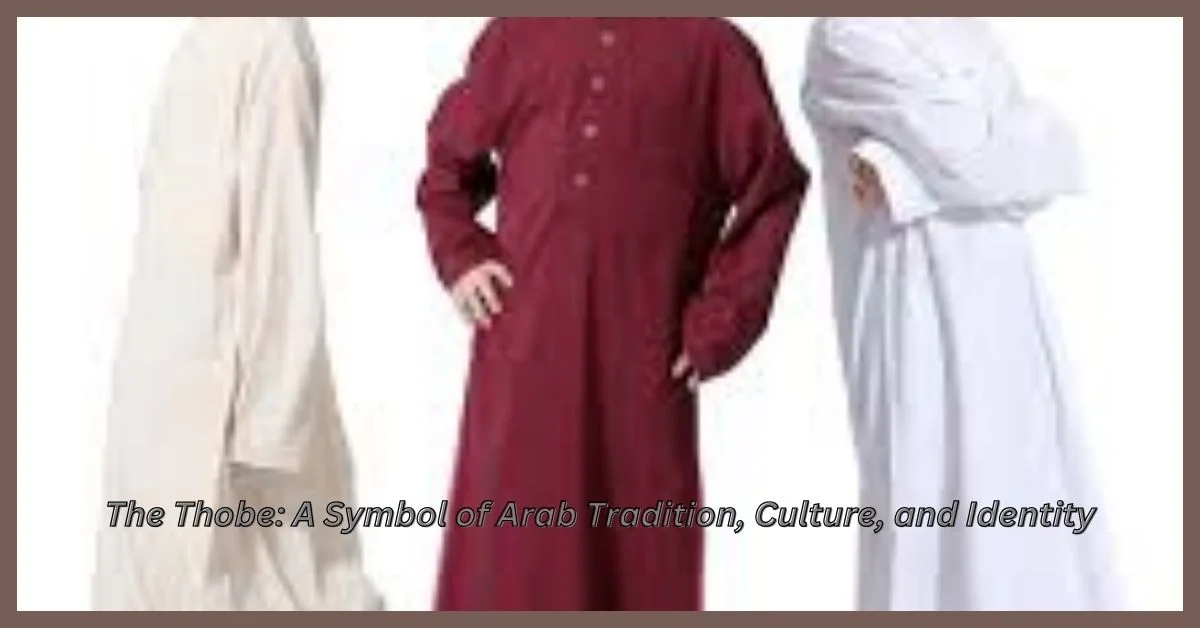Arab countries are rich in cultural heritage, history, and traditions. Among the many elements that define the region’s identity, one of the most recognizable symbols is the traditional attire known as the Thobe. A staple in many Arab countries, it is more than just a piece of clothing—it is a reflection of the region’s cultural, social, and religious values. In this article, we will explore the significance of the Thobe, its history, how it is worn, and why it continues to be a cherished part of Arab tradition.
What is a Thobe?
The Thobe (also called Thawb, Dishdasha, Kandura, or Dishdasha) is a long, ankle-length robe traditionally worn by men in various parts of the Arab world. The design is simple yet elegant, often made from lightweight fabrics like cotton, linen, or synthetic fibers, making it especially suited for the hot and dry climates of the Arabian Peninsula and other Middle Eastern regions. It is a staple piece of clothing in countries such as Saudi Arabia, United Arab Emirates (UAE), Qatar, Kuwait, Oman, and Bahrain—known collectively as the Gulf Cooperation Council (GCC) nations. The garment is also worn in countries like Iraq, Jordan, Syria, Palestine, and parts of North Africa, and East and West Africa.
It is characterized by its loose fit, long sleeves, and floor-length design. It is often white or in muted colors, but during colder months or for formal occasions, darker shades such as black, grey, or brown may be worn. In its simplicity, it embodies comfort, functionality, and elegance, making it a symbol of not just personal style, but of cultural identity as well.
Historical Significance of the Thobe
The Thobe has deep roots in the history of the Arab world. Its origins can be traced back to the pre-Islamic era when garments similar to these were worn by people in the Arabian Peninsula and the surrounding regions. Historically, the attire was functional, providing protection from the harsh desert climate and offering coolness in the heat and warmth in the cold.
Over the centuries, the Thobe has evolved into a symbol of cultural and religious identity. It is not just a garment; it is a representation of the pride Arab men take in their heritage and a visual marker of their belonging to a certain community or culture. Even as the Arab world has modernized, it remains a powerful symbol of continuity and respect for tradition.
Cultural and Religious Importance of the Thobe
In many Arab countries, it is much more than just everyday attire—it is a symbol of dignity, respect, and adherence to cultural and religious values. Its significance is especially prominent during religious occasions such as Ramadan, Eid, and Friday prayers at the mosque. The Thobe’s connection to religious practices stems from the Islamic tradition of modesty and the belief that clothing should cover the body in a way that respects social norms and divine commandments.
In addition to its religious significance, it plays a key role in defining one’s social status and regional identity. In some countries, the color, quality of the fabric, and the design of the Thobe can indicate a person’s social or economic standing. For example, fabrics made from high-quality fabrics like silk or fine wool may be worn by individuals of higher social or economic status, while those in lower social strata may wear simpler designs or fabrics.
In Saudi Arabia, it is also a symbol of national pride. The Saudi government has made efforts to preserve and promote it as a symbol of Saudi identity, with local designers and tailors offering modern takes on the classic garment.
Why Wear the Thobe?
The Thobe is widely appreciated for its comfort, practicality, and modesty, particularly in the scorching heat of the desert. Here are a few key reasons why men in the Arab world continue to wear the Thobe:
- Climate Adaptability: The Arab world, particularly the Gulf region, is known for its extreme heat and arid conditions. The Thobe, being made of lightweight and breathable materials such as cotton or linen, is designed to keep the wearer cool. The loose fit and long sleeves ensure that air circulates freely around the body, helping to prevent overheating.
- Cultural Identity: It is a key element of Arab cultural identity. Wearing it is a statement of belonging to the rich traditions of the Arab world. As societies continue to globalize and modernize, it remains a way for Arab men to assert their cultural heritage and values.
- Comfort and Practicality: Unlike tight-fitting Western attire, it’s loose design ensures maximum comfort throughout the day. Its easy-to-wear design also makes it practical for many activities. Whether at home, in the office, or attending social events, the Thobe provides a high degree of comfort, making it suitable for a wide variety of occasions.
- Modesty: Modesty is a central concept in Islamic teachings, and it reflects this principle. The loose, flowing nature of the garment helps men maintain a modest appearance, covering their bodies in a respectful way. It is a garment that upholds Islamic values of humility and decency.
- Elegance and Simplicity: Despite its simplicity, exudes a certain elegance. Its clean lines and minimalist design make it a garment suitable for both everyday wear and formal occasions. For special events like weddings, Eid celebrations, or family gatherings, the Thobe can be customized with intricate embroidery, luxurious fabrics, or added accessories, making it a versatile and timeless choice.
How to Wear the Thobe
Wearing it may seem straightforward, but there are certain nuances to consider, especially when it comes to fitting and styling the garment. Here’s a guide to help you understand how to wear a Thobe:
- Fit and Sizing: It comes in various sizes, and it is important to choose one that fits properly. While it is generally loose-fitting, it should not be so large that it becomes unmanageable. Ensure that the sleeves and length are appropriate for your height.
- Layering: In colder months or during special occasions, men may wear additional layers under their Thobe, such as a light undershirt or an Abaya (a loose-fitting overcoat). In some cases, it is worn with a ghutra (head covering) or agal (headband), particularly for more formal settings.
- Accessories: It can be paired with various accessories, including a bisht (a traditional overgarment worn for formal occasions), shoes (often sandals or leather slippers), and a head scarf (such as the keffiyeh or ghutra).
- Colors and Fabrics: While the classic Thobe is often white, it can come in various colors, depending on the season or occasion. For example, in the winter, darker colors like black, navy, or brown are more common. The fabric can vary from cotton for everyday wear to more luxurious fabrics like silk or wool for formal events.
- Occasions: It is versatile and can be worn in many settings. On a regular day, it serves as casual or business attire, but for religious or cultural ceremonies, it may be adorned with specific embellishments or accessories to mark the occasion’s importance.
The Thobe’s Role in Modern Society
Though the Thobe has deep historical and cultural roots, it remains a relevant and integral part of modern-day fashion in the Arab world. Over the years, designers have created contemporary versions of the Thobe, incorporating modern fabrics and styles to cater to the tastes and needs of a younger generation. Many young men today still choose to wear it for its timeless elegance and cultural significance, despite the growing popularity of Western fashion.
The Thobe also plays an important role in the political and cultural landscape. In countries like Saudi Arabia, it is a symbol of national pride and unity, and many prominent figures, including the royal family, continue to wear it as a reflection of their connection to the nation’s heritage. International leaders and diplomats who visit the Arab world are often presented with a Thobe as a gesture of respect and friendship.
Conclusion
The Thobe is much more than just a garment; it is a reflection of the Arab identity, a symbol of modesty, tradition, and cultural pride. Worn by men across the Arab world, from the Arabian Peninsula to parts of North Africa and beyond, it serves as both a practical and spiritual necessity, linking modern-day wearers to centuries of history and values.
In addition to its cultural and religious importance, the Thobe continues to be a symbol of elegance, comfort, and social status, adapting over time while preserving its deep-rooted ties to the past. Whether worn daily, during special occasions, or at formal events, the Thobe remains an enduring symbol of the Arab world’s rich cultural heritage.
FAQs About the Thobe
1. What is a Thobe?
A Thobe is a long, ankle-length robe worn by men in many Arab countries. It is often made of breathable fabrics like cotton and is a symbol of Arab cultural and religious identity.
2. Where is the Thobe worn?
The Thobe is primarily worn in Arab countries, especially in the Arabian Peninsula, including Saudi Arabia, the UAE, Qatar, Kuwait, and Bahrain. It is also worn in Iraq, Jordan, Syria, Palestine, and parts of North Africa and West Africa.
3. Why do men wear the Thobe?
Men wear the Thobe for reasons of comfort, modesty, and cultural identity. It helps protect from the hot desert climate, reflects religious values of modesty, and signifies a connection to Arab heritage.
4. What are the different names for the Thobe?
Depending on the region, the Thobe is also known as Dishdasha, Kandura, or Dishdasha in some countries of the Gulf region.
5. How do you wear a Thobe?
The Thobe is typically worn by slipping it over the head, ensuring it fits loosely and comfortably around the body. It can be accessorized with a ghutra, headband, or bisht for formal occasions.
6. Is the Thobe still relevant today?
Yes, the Thobe remains an essential garment in the modern Arab world. It has adapted to contemporary tastes, with designers offering modern variations while still holding cultural and religious significance.









